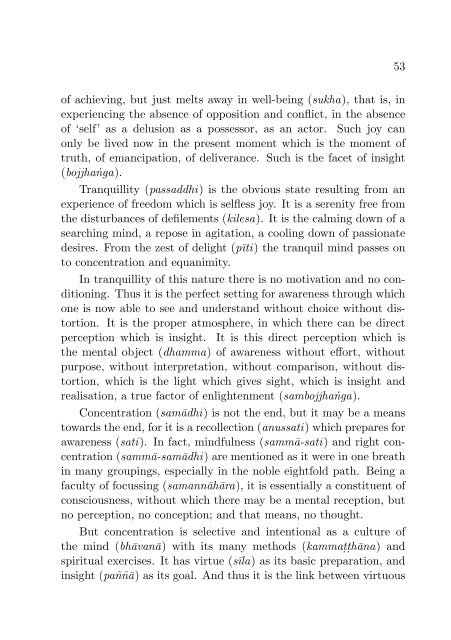Awareness in Buddhist Meditation
A detailed description of awareness in Buddhist Meditation.
A detailed description of awareness in Buddhist Meditation.
Create successful ePaper yourself
Turn your PDF publications into a flip-book with our unique Google optimized e-Paper software.
53<br />
of achiev<strong>in</strong>g, but just melts away <strong>in</strong> well-be<strong>in</strong>g (sukha), that is, <strong>in</strong><br />
experienc<strong>in</strong>g the absence of opposition and conflict, <strong>in</strong> the absence<br />
of ‘self’ as a delusion as a possessor, as an actor. Such joy can<br />
only be lived now <strong>in</strong> the present moment which is the moment of<br />
truth, of emancipation, of deliverance. Such is the facet of <strong>in</strong>sight<br />
(bojjhaṅga).<br />
Tranquillity (passaddhi) is the obvious state result<strong>in</strong>g from an<br />
experience of freedom which is selfless joy. It is a serenity free from<br />
the disturbances of defilements (kilesa). It is the calm<strong>in</strong>g down of a<br />
search<strong>in</strong>g m<strong>in</strong>d, a repose <strong>in</strong> agitation, a cool<strong>in</strong>g down of passionate<br />
desires. From the zest of delight (pīti) the tranquil m<strong>in</strong>d passes on<br />
to concentration and equanimity.<br />
In tranquillity of this nature there is no motivation and no condition<strong>in</strong>g.<br />
Thus it is the perfect sett<strong>in</strong>g for awareness through which<br />
one is now able to see and understand without choice without distortion.<br />
It is the proper atmosphere, <strong>in</strong> which there can be direct<br />
perception which is <strong>in</strong>sight. It is this direct perception which is<br />
the mental object (dhamma) of awareness without effort, without<br />
purpose, without <strong>in</strong>terpretation, without comparison, without distortion,<br />
which is the light which gives sight, which is <strong>in</strong>sight and<br />
realisation, a true factor of enlightenment (sambojjhaṅga).<br />
Concentration (samādhi) is not the end, but it may be a means<br />
towards the end, for it is a recollection (anussati) which prepares for<br />
awareness (sati). In fact, m<strong>in</strong>dfulness (sammā-sati) and right concentration<br />
(sammā-samādhi) are mentioned as it were <strong>in</strong> one breath<br />
<strong>in</strong> many group<strong>in</strong>gs, especially <strong>in</strong> the noble eightfold path. Be<strong>in</strong>g a<br />
faculty of focuss<strong>in</strong>g (samannāhāra), it is essentially a constituent of<br />
consciousness, without which there may be a mental reception, but<br />
no perception, no conception; and that means, no thought.<br />
But concentration is selective and <strong>in</strong>tentional as a culture of<br />
the m<strong>in</strong>d (bhāvanā) with its many methods (kammaṭṭhāna) and<br />
spiritual exercises. It has virtue (sīla) as its basic preparation, and<br />
<strong>in</strong>sight (paññā) as its goal. And thus it is the l<strong>in</strong>k between virtuous

















